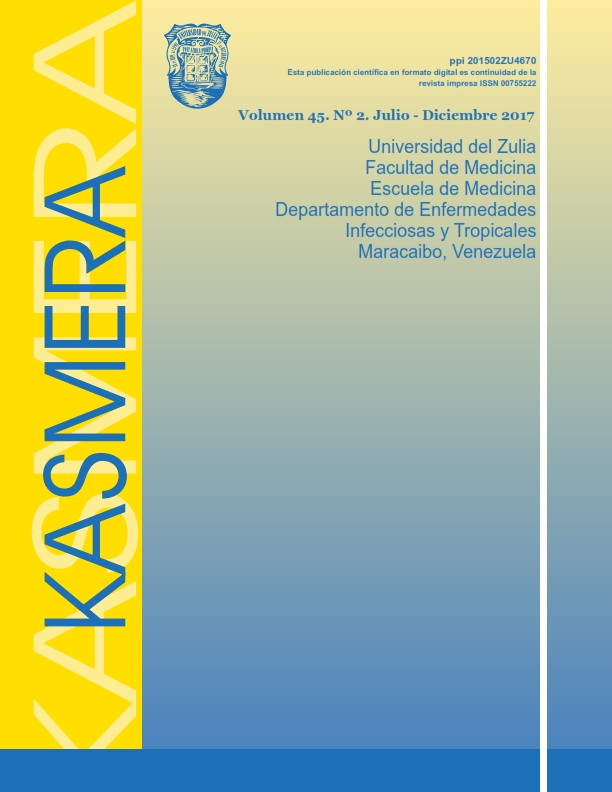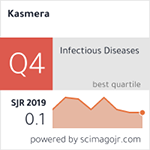Seroprevalence of toxoplasmosis in female patients attending the outpatient network of the municipality Francisco Linares Alcántara, Maracay, Aragua state, Venezuela
Abstract
Toxoplasmosis is a parasitic disease caused by Toxoplasma gondii. The infection in human occurs accidentally by different transmission mechanisms: oral, congenital, blood transfusions, organ transplants and from laboratory accidents. In Venezuela, it has been reported that 60% of the population apparently healthy have the infection. Taking into account its prevalence was determined the seroprevalence of toxoplasmosis in female patients aged 14-44 years of the
outpatient network Municipality Francisco Linares Alcántara, Maracay, State Aragua, Venezuela, implemented as methods of diagnosis the enzyme-linked immunosorbent assay (ELISA) and Indirect Hemagglutination (HAI) in 90 patients. Obtaining as a result of the ELISA method, a seroprevalence 61% where 98% presented antibodies IgG and IgM antibodies 2%, by the HAI method, was found 41% where 100% showed IgG antibodies. By means of the chi-square test with a significance level of 95% and a p value ≤0.005, we identified no statistically significant associations between risk factors and infection. However the group with the highest frequency of antibodies anti-T. gondii was represented by ages >34 years, proving that the risk of acquiring the infection increases with age.
References
Acha P, y Szyfres B. Zoonosis y enfermedades transmisibles comunes al hombre y a los animales. 3era ed. Washington D.C: OPS, 2001.
Botero D, Restrepo M. Parasitosis Humanas. 4ta ed. Medellín: Corporación para Investigaciones Biológicas. 2003. 252-269
Maekelt G, Toxoplasmosis. Manual de Medicina Tropical. Tomo II, Facultad de Medicina, Universidad Central de Venezuela; 2002. p 63-75.
Pantoja, A. y Pérez, L. Reseña histórica acerca de las investigaciones relacionadas con la toxoplasmosis. Revista Cubana Medicina Tropical, 53 2001; 2: 11-17.
Zuzunaga M, Chávez A, Li O, Evaristo R. Toxoplasma gondii en vicuñas de la reserva nacional de Pampa Galeras. Revista de Investigaciones Veterinarias del Perú, 2006; 17(2):173-177.
Chiaretta A, Sbaffo A, Cristofolini A, Molina M. Estudio Seroepidemiológico de la Toxoplasmosis en niños de áreas de riesgo de la ciudad de Rio Cuarto. Córdoba. Argentina. Parasitol Latinoam. 2003; 58:112-117.
Díaz O, Parra A, Araújo M. Seroepidemiología de la Toxoplasmosis en una comunidad marginal del Municipio de Maracaibo, Estado Zulia. Invest Clin. 2001; 42:107-121.
Ianiro J, Moscardi F. Prevalencia de Anticuerpos anti Toxoplasma gondii en embarazadas concurrentes al Hospital Privado de Mar de Plata. Rev del Hospital Privado de comunidad. 1988. 45-5, 100-105.
Pantoja A, Perez L. Reseña Histórica acerca de las investigaciones relacionadas con la Toxoplasmosis. Rev Cubana Med Trop. 2001. 53:15-17.
Delgado I, Piña N, Garcias A. Comportamiento de la infección toxoplásmica. Revista Electrónica de las Ciencias Médicas en Cienfuegos, 2009. 7(1): 1-5.
Martin-Hernández L, García-Izquierdo, MS. Toxoplasmosis en el hombre. Red de Revista Científica de América Latina, el Caribe, España y Portugal. 2003. 28 (3):19-27.
Galván M, Castillo Y, Espinoza M, Bojorques M, Rodríguez L. Bernal, R, et al. Actue Infection of Toxoplasma gondii and cytomegalovirus reactivation in a pediatric patient receiving liver transplant. Transplant Infectious Disease. 2005. 8: 233-236.
Leon J, Gutierrez N, Agrela I. Manual para el trabajo practico en el laboratorio de inmunología. 2007; 4ta ed. Maracay: Universidad de Carabobo. 147-155.
Rolo A, Leañez J, González M, Landa M., Mora V. 2011. Factores asociados en la adquisición de toxoplasmosis en mujeres embarazadas. Red ambulatoria del Municipio Linares Alcántara. Estado Aragua. Enero-Julio 2009. Maracay. Universidad de Carabobo [Tesis de grado]. 27-35
Vaccaro L, Villegas B. 2009. Seroprevalencia de infección por Toxoplasma gondii en estudiantes femeninas de la Universidad de Carabobo sede Aragua. Maracay. Universidad de Carabobo. [Tesis de grado]. 43-54.
Fernández- Fernández J., Aguiar B., Borges J. 2007. Seroprevalencia de infección por Toxoplasma gondii en la comunidad el Viñedo, Municipio Girardot, Maracay-Estado Aragua [Tesis de grado] Universidad de Carabobo. Maracay. 23-28.
Jacome J. 2007. Prevalencia de la infección por Toxoplasma gondii en mujeres embarazadas, en Valledupar, Santa Marta. Universidad del Magdalena. [Tesis de grado].34-53.
American Association of Feline Practitioners. 2003. Report on feline zoonoses. Compendium. 25 (12), 881-992.
Copyright (c) 2017 Amelia González, Camejo Meryvic, Yoneyra Castillo

This work is licensed under a Creative Commons Attribution-NonCommercial-ShareAlike 4.0 International License.
Kasmera journal is registered under a Creative Commons an Attribution-NonCommercial-ShareAlike 4.0 International (CC BY-NC-SA 4.0), available at: https://creativecommons.org/licenses/by-nc-sa/4.0/deed.en; which guarantees the freedom to share-copy and redistribute the material in any medium or format and adapt-remix, transform and build from the material, provided that the name of the authors, the Department of Infectious and Tropical Diseases, Zulia´s University and Kasmera Journal, you must also provide a link to the original document and indicate if changes have been made.
The Department of Infectious and Tropical Diseases, University of Zulia and Kasmera Journal do not retain the rights to published manuscript and the contents are the sole responsibility of the authors, who retain their moral, intellectual, privacy and publicity rights. The guarantee on the intervention of the manuscript (revision, correction of style, translation, layout) and its subsequent dissemination is granted through a license of use and not through a transfer of rights, which represents the Kasmera Journal and Department Infectious Diseases, University of Zulia are exempt from any liability that may arise from ethical misconduct by the authors.
Kasmera is considered a green SHERPA/RoMEO journal, that is, it allows self-archiving of both the pre-print (draft of a manuscript) and the post-print (the corrected and peer-reviewed version) and even the final version (layout as it will be published in the journal) both in personal repositories and in institutional and databases.











_pequeño1.png)

_pequeña.png)









_pequeña.png)




_pequeña.jpg)






